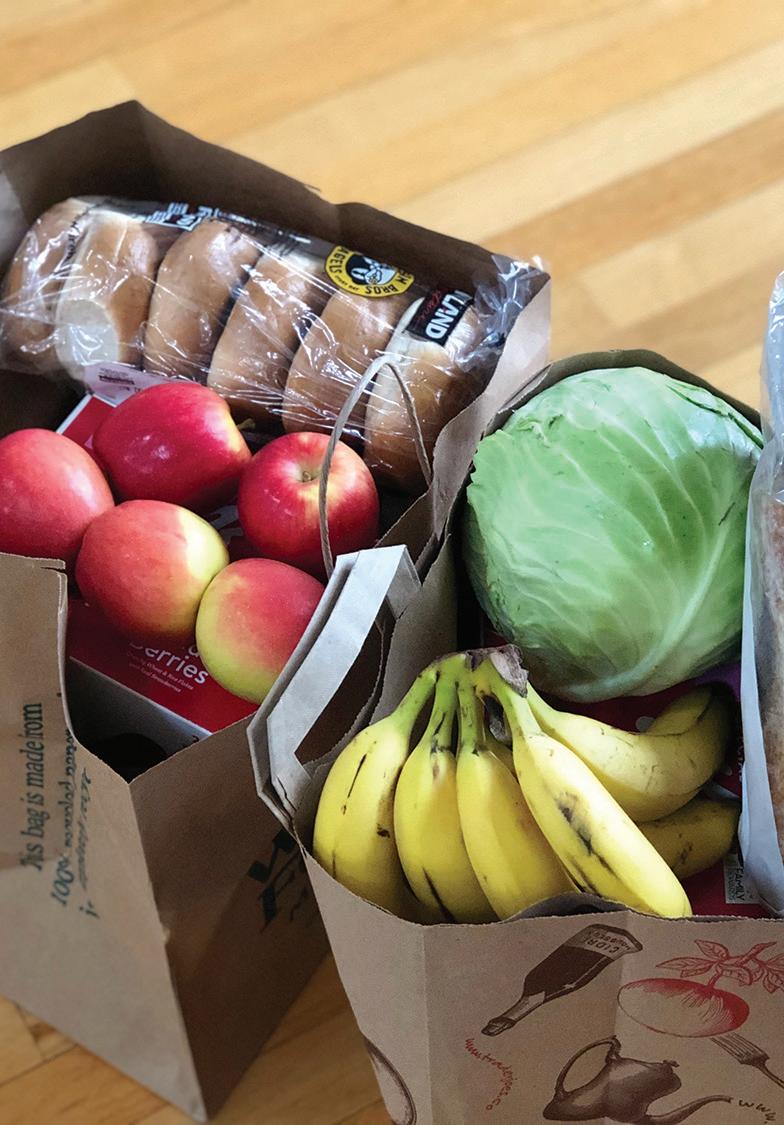
5 minute read
Feeding Kids Well During Covid
Enlist older kids in food prep or baking to keep grocery runs and takeout orders to a minimum. Use the last few shreds of chicken on tomorrow’s salad or that last bit of spaghetti sauce as a base for homemade pizza.
How to encourage healthy eating without turning into the pantry police.
Advertisement
By Malia Jacobson
Along with reducing kids’ physical activity, the ongoing pandemic is affecting what, when, and how much kids eat. With healthy food in shorter supply for many families, children are making up the difference with empty, junk-food calories, says Phuong V. Truong, RDN, clinical dietitian with the Odessa Brown Children’s Clinic at Seattle Children›s Hospital. “At this time the most dire need is access to healthy food. Kids no longer have access to meals at school, and we have families who no longer have access to food drops because of COVID.”
The negative health impacts could take years to reverse, particularly for children in lower-income households, those with one caregiver at home, or those already struggling to put food on the table before COVID, says Truong. While local school districts have made school lunches available during remote schooling, many families can’t get to the pickup location at the right time. “Families who rely on public or shared transportation aren’t going to be able to get to the school or pickup location, which puts an added strain on the food supply at home,” she says.
For families with kids learning at home, finding time to shop for fresh foods is a problem, especially if parents also need to work while they supervise remote schooling. “Either parents need to find childcare just to go shopping for food, take young kids to the store, or pay extra for grocery delivery, which can be costly. And food costs are rising, so dollars don’t stretch as far as they used to,” says Truong.
Free and low-cost sources of nutritious foods like community vegetable gardens and local fresh-food markets are less active during the winter, so access to nutritious food probably won’t improve over the next few months. “I’m seeing kids with health conditions like obesity and fatty liver disease worsening, with less physical activity and no change in sight,” Truong says. “It really scares me, because we’re still in survival mode at this point. We haven’t had time to evaluate what’s going on, let alone intervene, so this isn’t even being addressed.”
CREATE MEAL PATTERNS
You can’t control global food supply, but you can protect your own stash. Keep kids from devouring an entire weeks’ worth of groceries in a sitting by setting up boundaries: Stick to regular meal and snack times, with only water offered in between. Schooling at home should not mean children have unrestricted access to food throughout the day, notes Truong. Constantly hitting the cabinet or fridge for snacks racks up unneeded calories and strains the family’s food supply. Continued on pg. 26 >>>

PHOTO BY MARIA-LIN-KIM, UNSPLASH
How to connect with support
Times are tough, but federal and local programs are available to help: The federal government is funding hunger prevention through the Family
First Coronavirus
Response Act and the Coronavirus
Aid, Relief, and Economic Security
(CARES) Act. The federal Supplemental
Nutrition Assistance Program (SNAP)
provides food support for those who meet income qualifications. More information about SNAP and other federal food support programs is available online.
ESTABLISH NON-FOOD COMFORTS, REWARDS, AND “FIDGETS”
Lots of kids are overeating out of stress, boredom, or to pass the time during long remote learning sessions, says Truong. Break out of these budget-busting ruts with non-food alternatives. Rewards could include a family drive or walk, a movie, or an at-home mani-pedi night; a bath, music, or playtime with a pet can relieve stress; fidget spinners or a sketch pad and pencil can keep hands busy without snacking during Zoom meetings.
STRETCH FOOD DOLLARS FURTHER
Food costs may be rising, but fresh produce and bulk foods are still budget-friendly bets for families, says Truong. Shop the perimeter of the store first to fill your cart with low cost foods like fruits and vegetables, then skim the aisles for healthy packaged items like popcorn, oatmeal, canned fruit packed in water, frozen vegetables, beans, and pasta.

COOK TOGETHER INSTEAD OF ORDERING OUT
Establish a regular COTR (clean out the refrigerator) night to ensure that leftovers are eaten instead of tossed; stir-fries, curries, and soups are easy ways to use leftover meats and vegetables. Use low-cost convenience foods like salsa and salad dressings as cooking aids: ½ cup of salsa adds flavor to a pot of black bean soup, a dash of your family’s favorite salad dressing turns boiled diced potatoes into a hearty, healthy side dish. Use the last few shreds of chicken on tomorrow’s salad or that last bit of spaghetti sauce as a base for homemade pizza.
Enlist older kids in food prep or baking to keep grocery runs and takeout orders to a minimum. You don’t need a vigorous sourdough base, a bread machine, or even a talent for baking to make simple, low-cost bread for sandwiches or toast. Buy active dry yeast in bulk and stock up on flour to bake up toasty fresh bread that can be served alone or alongside comforting, nourishing homemade meals. r Malia Jacobson is a health and family journalist.

Limited Space Still Available
Contact us to schedule your virtual tour today!
St. Paul’s is a K-8 independent school located steps from Lake Merritt. We welcome families of all faiths or none.
510-285-9617 www.spes.org
A transformative education built on fearless learning, service, and diversity.

CollegePrep
A private high school in Oakland
Tucked into a glen in the Rockridge neighborhood of Oakland, College Prep’s informal and welcoming campus provides an educational home for a lively and talented community of students in grades 9-12. Guided by inspiring teachers and mentors, they create a vibrant community that is rooted in shared values of kindness, respect, and a willingness to learn from the perspectives of others. We invite you to visit us and experience College Prep first-hand.
6100 Broadway Oakland CA 94618 510.652.4364 college-prep.org
HOLY NAMES HIGH SCHOOL
EST 1868 OAKLAND, CA
Holy Names High School









